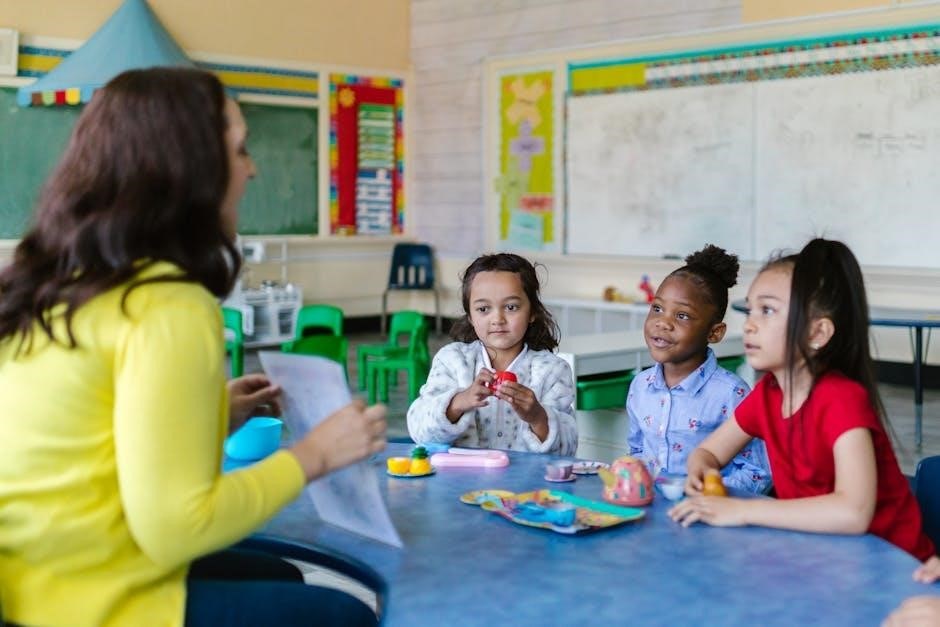The Year 5 Maths curriculum builds on previous learning, focusing on mastering key skills in number, fractions, geometry, and problem-solving․ It emphasizes logical reasoning and real-world applications to prepare students for higher-level mathematics․
1․1 Overview of Key Stage 2 Maths
Key Stage 2 Maths, spanning Years 3 to 6, builds foundational skills in number, geometry, and problem-solving․ Year 5 is central, refining concepts like place value, fractions, and mental maths․ The curriculum emphasizes logical reasoning, preparation for secondary school, and practical applications, ensuring students develop confidence and fluency in mathematical thinking․
1․2 Importance of Year 5 in Maths Development
Year 5 is a pivotal year in maths development, consolidating earlier learning and introducing complex concepts․ It bridges primary and secondary education, enhancing problem-solving skills and mathematical fluency․ Mastery of Year 5 topics like fractions, place value, and multi-step problems prepares students for the challenges of Year 6 and beyond, fostering a strong foundation for future academic success․
Number and Place Value
Focuses on reading, writing, and comparing numbers up to 1,000,000, understanding negative numbers, and determining the value of each digit in complex numbers․
2․1 Reading, Writing, and Comparing Numbers to 1,000,000
Students learn to read, write, and compare numbers up to one million, understanding the significance of each digit in large numbers․ They practice ordering numbers and identifying their place value, enhancing their number sense and ability to handle complex numerical data effectively in various mathematical contexts․
2․2 Understanding Negative Numbers in Context
Students explore negative numbers in real-life contexts, such as temperature and debt․ They learn to interpret, compare, and use negative numbers in practical scenarios․ This includes counting backwards and forwards through zero, enhancing their understanding of number relationships․ Mastering negatives supports problem-solving and builds a strong foundation for advanced mathematical concepts in later years․
2․3 Counting Forwards and Backwards in Steps of Powers of 10
Students learn to count forwards and backwards in steps of powers of 10, such as 10, 100, and 1,000․ This skill enhances their understanding of place value and large numbers․ Activities involve starting from any given number and counting in increments of 10, 100, or 1,000, reinforcing number relationships and mental maths strategies for precise calculations․
2․4 Determining the Value of Each Digit
Students learn to identify and calculate the value of each digit within a number, understanding its place value (units, tens, hundreds, etc․)․ This involves breaking down numbers into their constituent digits and calculating their individual worth․ For example, in 456, the ‘4’ represents 400, ‘5’ represents 50, and ‘6’ represents 6․ This skill is essential for operations like subtraction and multiplication, ensuring accuracy in calculations․

The Four Operations
This section focuses on mastering addition, subtraction, multiplication, and division of larger numbers, as well as solving word problems involving these operations with accuracy and confidence․
3․1 Addition and Subtraction of Larger Numbers
Students learn to add and subtract multi-digit numbers using formal written methods․ They apply columnar addition and subtraction to solve problems involving money and real-world scenarios, ensuring accuracy in their calculations․
3․2 Multiplication and Division of Larger Numbers
Students master multiplication and division of larger numbers using formal written methods․ They apply column multiplication, short division, and interpret remainders․ Emphasis is placed on understanding place value to solve multi-step problems accurately, preparing them for more complex calculations in higher grades while ensuring fluency in arithmetic operations․
3․3 Solving Word Problems Involving the Four Operations
Students learn to solve word problems using the four operations, applying addition, subtraction, multiplication, and division in practical contexts․ They use formal written methods to calculate totals, interpret remainders, and verify solutions․ Emphasis is placed on understanding the context, selecting appropriate operations, and breaking problems into manageable steps to ensure accuracy and confidence in mathematical reasoning․
Fractions
The curriculum introduces proper and improper fractions, focusing on addition, subtraction, and multiplication․ Students learn to convert decimals to fractions and apply these skills in real-world problems․
4․1 Understanding Proper and Improper Fractions
Students learn to identify and convert between proper and improper fractions, recognizing mixed numbers as a combination of whole numbers and fractions․ They explore real-world applications, such as dividing resources or measuring ingredients, to understand the practical use of fractions in everyday situations, enhancing their mathematical reasoning and problem-solving skills effectively․
4․2 Adding and Subtracting Fractions with the Same Denominator
Students learn to add and subtract fractions with the same denominator by simply adding or subtracting the numerators while keeping the denominator unchanged․ This concept is applied to solve practical problems, such as measuring ingredients or dividing objects equally․ The focus is on understanding the relationship between numerators and denominators to develop confidence in fraction operations and improve problem-solving skills․
4․3 Multiplying Fractions by Whole Numbers
Students learn to multiply fractions by whole numbers by multiplying the numerator by the whole number, while the denominator remains the same․ For example, ( rac{3}{4} imes 5 = rac{15}{4} )․ This concept is applied to solve real-world problems, such as scaling recipes or calculating distances․ Visual aids and practical examples help students grasp this fundamental operation in fraction arithmetic․
4․4 Converting Decimals to Fractions
Students learn to convert decimals to fractions by reading the decimal as a number over 100, simplifying if possible․ For example, 0․71 becomes 71/100, which can be reduced to 71/100․ This skill helps students understand the relationship between decimals and fractions, aiding in measurements, proportions, and further fraction operations․ Practical examples and visual representations reinforce this concept for better understanding and application․
Geometry and Shape
Students explore properties of 2D and 3D shapes, identifying symmetry, and understanding angles․ They learn to classify shapes and describe their features, enhancing spatial awareness and problem-solving skills․
5․1 Properties of 2D and 3D Shapes
In Year 5, students identify and describe the properties of 2D and 3D shapes, including vertices, edges, and faces․ They classify shapes based on their features, such as symmetry and angles, and explore how these properties can be used to solve problems․ This understanding helps build a strong foundation for more complex geometry concepts later in their mathematical journey․
5․2 Identifying Symmetry in Shapes
Students learn to identify and describe symmetry in 2D and 3D shapes, focusing on line symmetry and rotational symmetry․ They explore how shapes can be reflected or rotated to match their original appearance․ This concept helps in understanding patterns and classifications, enhancing spatial awareness and problem-solving skills in geometry and real-world applications like art and design․
5․3 Understanding Angles and Their Measurement
Students explore angles, learning to identify, measure, and compare them using protractors․ They understand basic angle types, such as acute, obtuse, right, and straight angles, and how to calculate angles up to 180 degrees․ This skill enhances their ability to classify shapes and solve geometric problems, while practical applications in design and construction illustrate real-world relevance․

Measurement
Includes measuring perimeter, area, and converting units․ Students calculate time intervals, understand money totals, and apply measurement skills in practical, real-world scenarios to enhance problem-solving abilities․
6․1 Telling and Writing Time Notation
The curriculum focuses on accurately telling and writing time in both digital and analog formats․ Students learn to convert between 12-hour and 24-hour notation, understanding AM/PM conventions․ They practice reading time to the nearest minute and writing times in numerical and word formats․ This skill is essential for problem-solving and real-world applications, such as scheduling and time management․
6․2 Calculating Time Intervals

The curriculum emphasizes calculating time intervals, including subtracting and adding time․ Students learn to determine start and end times, convert between 12-hour and 24-hour formats, and solve problems involving durations․ Practical applications include interpreting timetables and schedules․ This skill enhances problem-solving abilities and prepares students for real-world scenarios requiring accurate time management and organization․
6․3 Understanding Money and Calculating Totals
Students learn to add and subtract amounts of money, calculate totals, and determine change․ They practice using £ and p symbols, converting between pounds and pence, and applying these skills to real-life scenarios, such as shopping and budgeting․ This builds financial awareness and problem-solving abilities, essential for everyday transactions and decision-making․
6․4 Measuring Perimeter and Area
Students learn to calculate the perimeter of 2D shapes by adding the lengths of all sides and determine the area by counting squares or using formulas․ They explore strategies for estimating and comparing areas, applying these concepts to real-world problems like designing spaces or planning layouts, fostering spatial reasoning and problem-solving skills․

Problem Solving Strategies
Students develop mental maths techniques and apply formal methods to solve complex problems․ They learn to break down multi-step word problems, enhancing critical thinking and mathematical reasoning skills․
7․1 Using Mental Maths Techniques
Students learn to apply mental maths strategies for quick calculations, such as counting in steps, using place value understanding, and interpreting negative numbers․ These techniques enhance problem-solving speed and accuracy, preparing pupils for more complex mathematical challenges․ Mental maths is reinforced through practical applications and real-world scenarios, ensuring a strong foundation for future learning․
7․2 Applying Formal Written Methods
Students are taught to use columnar addition, subtraction, multiplication, and division for larger numbers․ These methods ensure accuracy and systematic approaches to complex calculations․ Pupils learn to align numbers correctly, carry over values, and interpret remainders․ Formal written methods build confidence and fluency in handling multi-digit operations, preparing students for more advanced mathematical challenges in subsequent years․
7․3 Solving Multi-Step Word Problems
Students develop skills to tackle complex word problems involving multiple operations․ They learn to identify key information, break problems into manageable steps, and apply formal methods․ Emphasis is placed on checking reasonableness and presenting clear solutions․ These challenges enhance critical thinking and prepare pupils for real-world mathematical applications, fostering confidence in handling diverse problem types effectively․
Assessment and Progression
Assessment and Progression in Year 5 Maths involves regular evaluations to track students’ understanding and progress․ It ensures they meet end-of-year expectations and are well-prepared for Year 6․
8․1 End of Year 5 Expectations
By the end of Year 5, students are expected to read, write, and compare numbers up to 1,000,000, understanding each digit’s value․ They should interpret negative numbers, perform operations like multiplication and division with larger numbers, and solve word problems․ Students are also expected to add and subtract fractions, convert decimals to fractions, and demonstrate skills in geometry and measurement, ensuring a solid foundation for Year 6․
8․2 Key Performance Indicators in Maths
Key Performance Indicators in Year 5 Maths include accurately reading, writing, and comparing numbers up to 1,000,000, and determining each digit’s value․ Students should interpret negative numbers, perform operations like multiplication and division with larger numbers, and solve multi-step word problems․ Proficiency in adding and subtracting fractions, converting decimals to fractions, and demonstrating geometry and measurement skills are also critical indicators of progress․
8․3 Transition to Year 6 Maths Curriculum

The Year 5 Maths curriculum lays the foundation for Year 6 by consolidating skills in number, fractions, geometry, and problem-solving․ Students transition with confidence in formal methods, multi-step word problems, and applying mathematical reasoning․ Year 6 will introduce more complex concepts such as algebra, ratios, and advanced geometry, building on the mastery achieved in Year 5 to prepare for secondary education․

Resources and Support
Recommended workbooks, online tools, and teaching resources provide comprehensive support for Year 5 Maths, ensuring differentiated instruction and mastery of curriculum objectives for all learners․
9․1 Recommended Workbooks and Answer Books
Recommended workbooks and answer books for Year 5 Maths provide structured practice in number, fractions, geometry, and problem-solving․ Resources like the CGP Year 5 Maths Homework Book offer comprehensive exercises aligned with curriculum objectives․ Past SATs papers and online PDF bundles also support revision and mastery of key skills, ensuring pupils can track their progress effectively throughout the year․
9․2 Online Tools and Video Tutorials
Online tools and video tutorials provide interactive learning experiences for Year 5 Maths․ Websites like keystage2maths․com offer free resources, including video lessons on number, fractions, and geometry․ These tools cater to different learning styles, enabling pupils to grasp concepts at their own pace․ Additionally, platforms like YouTube and educational apps offer visual and engaging content to support curriculum objectives and reinforce classroom teaching effectively․
9․3 Teaching Resources for Differentiated Instruction
Teaching resources for differentiated instruction in Year 5 Maths include tailored workbooks, interactive activities, and classroom strategies․ Resources like CGP Year 5 Maths Homework Book and online platforms provide varied difficulty levels, ensuring all learners are challenged appropriately․ These tools help teachers cater to individual needs, fostering an inclusive and effective learning environment that supports students’ diverse abilities and learning styles effectively․
